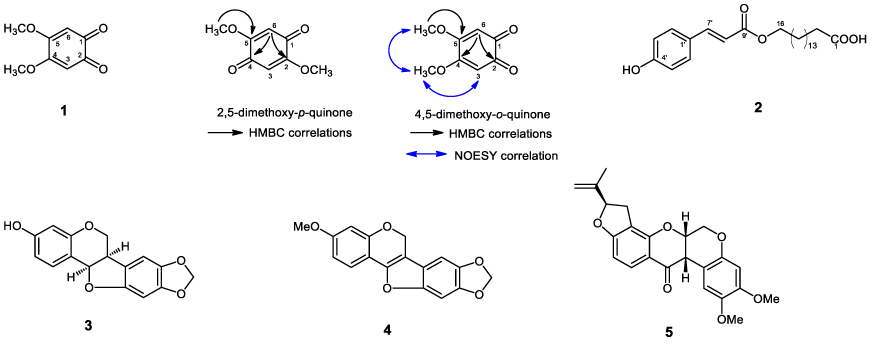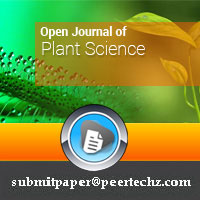Open Journal of Plant Science
O-Benzoquinone and Ester-Linked Hydroxyfatty Acid as Additional Compounds from Lonchocarpus nicou
Ata Martin Lawson*
Cite this as
Lawson AM (2016) O-Benzoquinone and Ester-Linked Hydroxyfatty Acid as Additional Compounds from Lonchocarpus nicou. Open J Plant Sci 1(1): 001-004, DOI: 10.17352/ojps.000001New O-Benzoquinone and a C16 long-chain para-coumarate ester were isolated from Lonchocarpus nicou roots. Their structural elucidations are based on different spectroscopic data analysis. In addition, the known pterocarpanoids maackiain and flemichapparin-B never reported in L. nicou were also isolated along with rotenone, the major phytochemical from this tropical liana.
Introduction
Extensive chemical investigations of the lipophilic extract of Lonchocarpus nicou roots, a tropical liana of the Fabaceae family [1], have led to numerous flavonoids [2-5]. In fact, in earlier publications we reported the isolation of modified B-ring (coumaronochromone) or C-ring rotenoids (seco-rotenoids) and hydroxyrotenoids along with others well-known rotenoids [3-5]. In addition to these metabolites, we now wish to report the isolation of two additional compounds: an O-Benzoquinone and a long alkanoic chain (C16: palmitic acid) ester of para-coumaric acid. Their chemical structures were established by spectroscopic methods UV, MS as well as 1D and 2D NMR. The present work aims to achieve better understanding phytochemical composition of L. nicou, since new families of compounds were isolated (quinone, p-coumaric acid derivative and pterocarpanoids).
Materials and Methods
General experimental procedure
MPLC was conducted using Büchi 681 pump (max. pressure = 40 bars) connected to Büchi columns with different sizes (460 x 26 mm; 460 x 15 mm; 230 x 15 mm) and stationary phases such as: SiO2-diol (Merck LiChroprep DIOL, 15-40 µm), SiO2 (Merck LiChroprep Si 60, 15-25 µm) and polyamide (Macherey-Nagel SC-6, < 70 µm). Circular Centrifugal TLC were performed on Chromatotron apparatus (model 8924 Harrison Research) equipped with RHSY pump model. NMR spectra were recorded on Bruker DPX Avance 400 MHz at 298 K. Chemical shifts were expressed in δ (ppm) referring to TMS for both 1H and 13C NMR experiments. Characteristic NMR resonances were assigned on the basis of 1D and 2D experiments: COSY, HMQC, HMBC and NOESY. HRESMS spectra were performed on a Q-TOF System spectrometer.
Plant material
L. nicou roots (1 kg) were obtained as a gift from the firm Sedagri-Rue de la Méditerranéenne, F-34300 Agde. A voucher specimen has been deposited at Laboratoire de Pharmacognosie de Grenoble-Domaine de La Merci, F-38700 La Tronche.
Extraction and isolation
The Air-dried roots (200 g) of L. nicou were powdered and extracted by soaking successively at room temperature in 1L of hexane, benzene, chloroform, acetone and methanol for 2 days. The extracts were filtered and the process was repeated twice for each solvent. The filtrates were then combined and concentrated under reduced pressure to give brownish residues. The benzene crude extract (24 g), was then macerated with methanol. After recovery of 16.85 g of rotenone (main compound from L. nicou) that constitute the methanol insoluble portion, the soluble part (7.13 g) was subjected to MPLC using SiO2-Diol column (460 x 26 mm) as stationary phase. 14 Fractions (F1-F14) were collected from this column that was successively eluted with C614 (100%) (F1), C614-EtOAc (8:2) (F2, F3), C614-EtOAc-MeCOEt (7.5:2:0.5) (F4, F5, F6), C614-EtOAc-MeCOEt (7.3:2:1.2) (F7, F8), C614-EtOAc-MeCOEt (65:2.5:1) (F9), C614-CH2Cl2-EtOAc-MeCOEt (3.2:3.2:2.5:1.2) (F10), CH2Cl2-EtOAc-MeCOEt (6.4:2.6:1) (F11, F12), CH2Cl2-EtOAc-MeCOEt (6:3:1) (F13), CH2Cl2-EtOAc-MeCOEt (6:1:3) (F14).
F5 fraction (305 mg) was chromatographed again, by eluting with a gradient of C614-EtOAc-MeCOEt mixture, under MPLC with SiO2 column (460 x 15 mm) giving access to 6 combined fractions (A-F). Fraction a yielded maackiain (7 mg) and Fraction B (14 mg) led to flemichapparin-B (2 mg) after crystallization in MeOH.
F6 fraction (340 mg), after one more MPLC eluted in a gradient way from hexane-Toluene (7:3) to hexane-Toluene-MeOH (0.7:9:0.3) with SiO2 column (460 x 15 mm) and combination of similar fractions, has furnished 2 combined fractions (A1 and B1). The fraction B1 (17 mg) was then subjected to Sephadex LH-20 column (340 x 15 mm) chromatography [CHCl3-MeCOEt-MeOH (3:3.5:3.5)] followed by Circular Centrifugal TLC [Toluene to hexane-Toluene-MeOH (0.5:9:0.5)] to yield o-benzoquinone (1) (6.7 mg).
F10 fraction (251 mg) was one more subjected to MPLC with SiO2 column (460 x 15 mm) by using a gradient of C614-EtOAc-MeCOEt mixture. This purification process led to 3 combined fractions (A’-C’). The purification of fraction A’ (24 mg) was further realized by using another MPLC with polyamide column (230 x 15 mm) [gradient from hexane to CH2Cl2-MeCOEt-MeOH (5:2.5:2.5)] leading to 16-(E)-p-coumaroyloxypalmitic acid (2) (13.4 mg).
(-)-Maackian (3): Physical and spectral data are in accordance with those previously published in literature [6-8].
(-)-Flemichapparin-B (4): Physical and spectral data are in accordance with those previously published in literature [9,10].
(-)-Rotenone (5): Physical and spectral data are in accordance with those previously published in literature [11,12].
Results and Discussion
From benzene extract of L. nicou roots, two new compounds 1 and 2 were isolated together with the known maackian (3), flemichapparin-B (4) and rotenone (5) as described in Materials and Methods. Chemical structures of new compounds were elucidated as follows.
Compound 1 was isolated as a yellow needle which exhibited an intense UV band at λmax (MeOH): 288 and 408 nm respectively, supposing a large conjugated system. The molecular formula C8H8O4 was deduced from HRESMS (found: 169.0491; calcd: 169.0501 for [M+H]+). The 13C NMR data display only four signals respectively at δ 178.9; 163.7; 103.0 and 57.1, suggesting a symmetric compound. Indeed, δ 178.9 was assigned to a carbonyl group whereas δ 163.7 was attributed as O-bonded quaternary sp2 C. Moreover, a shielded double bond carbon appears at δ 103.0 as well as a methoxy group at δ 57.1. 1H NMR analysis is also in accordance with a symmetric compound since only two signals were observed as singlets: δ 5.77 (δ 103.0) and δ 3.90 (δ 57.1). Therefore, two dimethoxybenzoquinone structures are possible in keeping with 1H, 13C, HMQC and HMBC NMR analysis: 2,5-dimethoxy-p-benzoquinone and 4,5-dimethoxy-o-benzoquinone. Further, the correlation observed in NOESY experiment led to elucidation of final structure unequivocally assigned as 4,5-dimethoxy-o-benzoquinone (1) for which the trivial name of lonchoquinone was proposed.
Compound 2 was isolated as a colourless amorphous solid which exhibited a UV band at λmax (MeOH): 242, 298 and 387 nm. The molecular formula was determined as C25H38O5 by HRESMS (found: 441.2630; calcd: 441.2617 for [M+Na]+). The 1H NMR data clearly showed two different partial structures: a para-coumaric acid moiety and a long carboxyalkyl chain. In fact, aromatic ortho-coupled (J =7.6 Hz) protons as displayed in 1H NMR data at δ 7.41 (2H) and δ 6.84 ppm (2H), suggested a 1,4-disubstituted benzene ring. Whereas, a hydroxyl group (δ 6.25 ppm) was placed at position 4, the other position (para) was supposed to be linked to conjugated ethylenic double bond involving a cinnamic acid derivative. These two ethylenic protons observed at δ 7.62 and δ 6.25 ppm were assigned as
In the aliphatic proton region, the 13C NMR spectrum showed 15 CH2 (64.7 ppm <δ < 26.0 ppm) and one terminal carboxylic group C-1 (δ 178.5 ppm). Moreover, 1H NMR spectrum displayed two triplets with the same intensity at δ 4.20 ppm (J =6.6 Hz) and δ 2.34 ppm (Table 1), (Figure 1).
(J =7.2 Hz) corresponding to two terminal methylene groups CH2-16 (δ 64.7 ppm) and CH2-2 (δ 33.8 ppm), respectively, attached to the ester linkage and to carboxylic acid group. The remaining CH2 were displayed as mutiplet at δ 1.67 ppm (2H), δ 1.63 ppm (2H) and δ 1.29 ppm (22H). Finally, the aliphatic part of this compound was identified as a C16 fatty acid (palmitic acid). Consequently, the above described compound was assigned as a new natural product named 16-(E)-p-coumaroyloxypalmitic acid (2). This compound probably resulted from esterification between the widespread para-coumaric acid and ω-hydroxypalmitic acid. To the best of our knowledge, except the para-coumaric acid methyl ester (C2 alkyl chain) isolated in Lonchocarpus xuul [13], alkyl para-coumarates are quite rare in Lonchocarpus genus. However, long-chain alkyl para-coumarates (Cn saturated or unsaturated) [14-18], are more frequently encountered in plant kingdom than carboxyalkyl para-coumarates derivatives even though a series of (E)-para-coumaroyl esters of ω-hydroxyfattyacids (C24 to C28) were already identified in minor amounts in the leaf fiber of Musa textilis [19] without any NMR data.
Conclusion
In summary, we report herein the first isolation of 4,5-dimethoxy-o-benzoquinone (1) and 16-(E)-p-coumaroyloxypalmitic acid (2) as natural products. Additionally to these newly reported compounds, two known pterocarpanoids (maackiain and flemichapparin-B) as well as the pivotal compound rotenone were also isolated from L. nicou roots. It is important to highlight the fact that this is the first isolation of these two known pterocarpanoids from L. nicou. Undoubtedly, this study constitutes a major contribution to the phytochemical investigation of L. nicou roots which is rotenoid-yielding plant as showed by previous studies.
The authors are grateful to “Région Limousin” for supporting a part of this work and Université of Limoges for research facilities.
- Southon WI (1994) Plants and their Constituents. In Phytochemical Dictionary of the Leguminosae; Edited by Bisby FA, Buckingham J, Harborne JB, Chapman and Hall, London .
- Lawson MA, Kaouadji M, Léger D, Liagre B, Allais D, et al. (2006) A series of thirty isoflavonoids from Lonchocarpus nicou: phytochemistry and preliminary antiproliferative evaluation, 22-25 August, Winnipeg (Canada). Edited by Daayf F, El Hadrami A, Adam L, Balance GM: Polyphenols Communications 95–96.
- Lawson MA, Kaouadji M, Allais DP, Champavier Y, Chulia AJ (2006) Substituted tubaic acids, new oxidative rotenoid metabolites from Lonchocarpus nicou. Tetrahedron Lett 47: 451–454 .
- Lawson MA, Kaouadji M, Chulia AJ (2008) nor-Dehydrodeguelin and nor-dehydrorotenone, C22 coumaronochromones from Lonchocarpus nicou. Tetrahedron Lett 49: 2407–2409 .
- Lawson MA, Kaouadji M, Chulia AJ (2010) A single chalcone and additional rotenoids from Lonchocarpus nicou. Tetrahedron Lett 51: 6116–6119 .
- Mizuno M, Tanaka T, Katsuragawa M, Saito H, Iinuma M (1990) New Pterocarpan from the Heartwood of Cladrastis platycarpa. J Nat Prod 53: 498-499 .
- Baruah P, Barua NC, Sharma RP, Baruah JN, Kulanthaivel P, et al. (1984) Flavonoids from Millettia pulchra. Phytochemistry 23: 443-447 .
- Dagne E, Yenesew A, Waterman PG (1989) Flavonoids and isoflavonoids from Tephrosia fulvinervis and Tephrosia pentaphylla. Phytochemistry 28: 3207-3210 .
- Dagne E, Bekele A, Waterman PG (1989) The flavonoids of Millettia ferruginea subsp. ferruginea and subsp. darassana in Ethiopia. Phytochemistry 28: 1897-1900.
- Roy M, Bhattacharya PK, Pal S, Chowdhuri A, Adityachaudhury N (1987) Dehydrodihydrorotenone and flemichapparin-B in Tephrosia candida. Phytochemistry 26: 2423-2424 .
- Carlson DG, Weisleder D, Tallent W (1973) NMR investigations of rotenoids. Tetrahedron 29: 2731-2741 .
- Nunlist R, Ralph J (1988) Rotenone NMR assignments. J heterocyclic Chem 25: 351-352 .
- Borges-Argaez R, Dias MEP, Waterman PG, Pena-Rodriguez LM (2005) Additional flavonoids from Lonchocarpus yucatanensis and L. xuul. J Braz Chem Soc 16: 1078–1081 .
- Hussein AA, Olmedo DA, Vasquez Y, Coley PD, Solis PN, et al. (2005) New cytotoxic cinnamic acid derivatives from leaves of Bonamia trichantha. Rev Latinoamer Quim 33: 90–96 .
- Mahmood U, Kaul VK, Acharya R, Jirovetz L (2003) p-Coumaric acid esters from Tanacetum longifolium. Phytochemistry 64: 851-853 .
- Hu J, Feng X (2000) Triterpenoids, p-coumaric acid esters and flavonoids from Artemisia igniaria. Planta Medica 66: 684-686 .
- Tori M, Ohara Y, Nakashima K, Sono M (2000) Caffeic and coumaric acid esters from Calystegia soldanella. Fitoterapia 71: 353-359 .
- Wandji J, Nkengfack AE, Fomum ZT, Ubillas R, Killday KB, et al.(1990) Erythrina studies. Part 18. A new prenylated isoflavone and long chain esters from two Erythrina species. J Nat Prod 53: 1425-1429 .
- Del Rio JC, Rodriguez IM, Gutierrez A (2004) Identification of intact long-chain p-hydroxycinnamate esters in leaf fibers of abaca (Musa textilis) using gas chromatography /mass spectrometry. Rapid Commun Mass Spectrom 18: 2691–2696 .
Article Alerts
Subscribe to our articles alerts and stay tuned.
 This work is licensed under a Creative Commons Attribution 4.0 International License.
This work is licensed under a Creative Commons Attribution 4.0 International License.


 Save to Mendeley
Save to Mendeley
